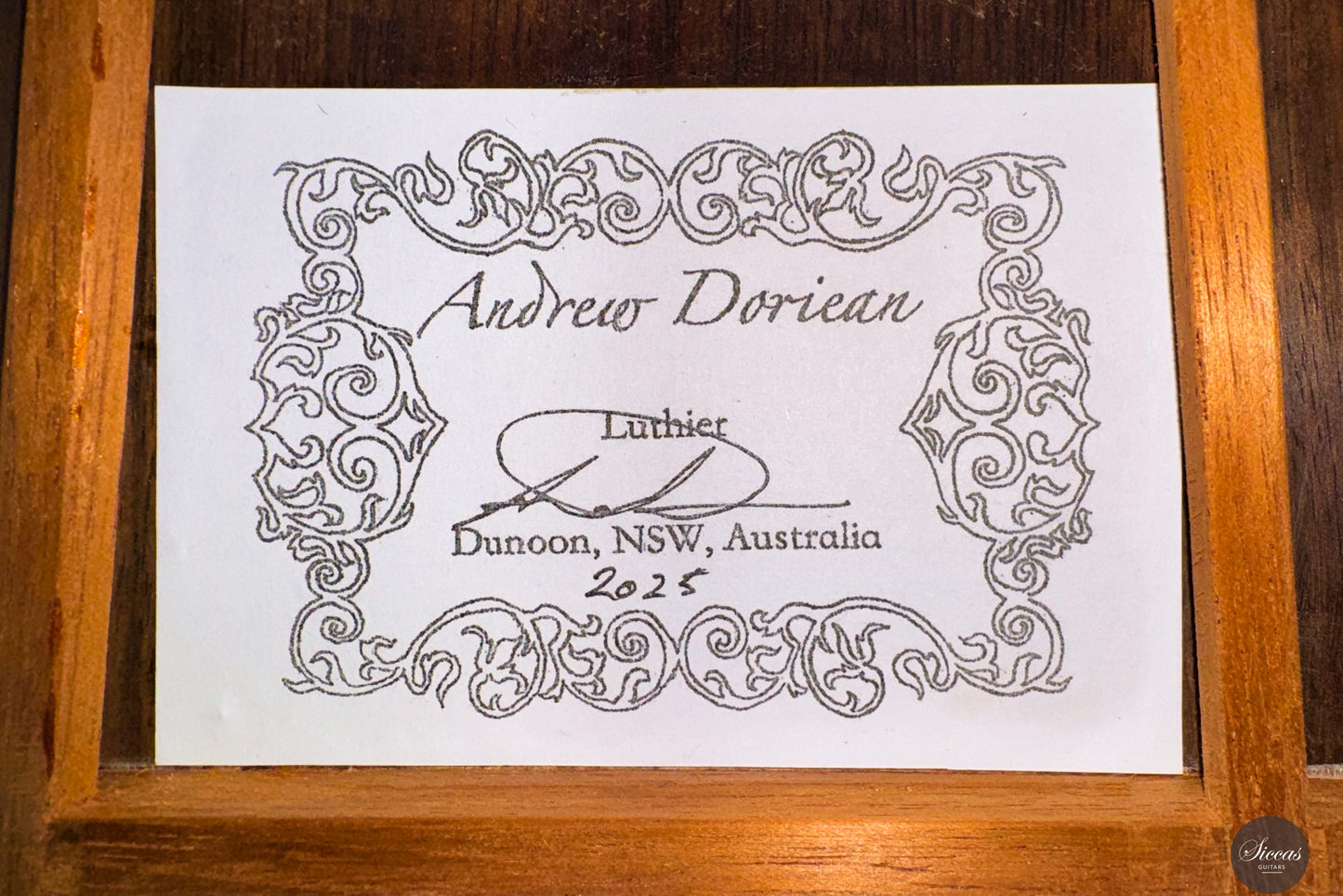Andrew Doriean - 2025
Andrew Doriean - 2025
Details
Details
Overview
Overview
Shipping important note
Shipping important note
Delivery times are typically reliable and most instruments arrive within the estimated timeframe.
Should any unexpected delay occur, our team will keep you informed and provide support at every step. For all shipping details and exceptions, please see our Shipping Policy.
Details about GPSR
Details about GPSR


























Video overview


More details about the guitar
About the luthier
Andrew Doriean builds guitars from his workshop in the Northern Rivers region of New South Wales, Australia. His path into lutherie combines a background in sound engineering, a family connection to woodworking, and a long-standing passion for the guitar. Over the last 18 years he has developed his own style by refining traditional methods and integrating carefully chosen modern innovations. While he draws inspiration from the great classical makers, his main focus is the creation of contemporary concert instruments that are responsive, versatile, and crafted with precision.About the guitar
This guitar from 2025 presents Andrew Doriean’s distinctive Feather Braced concept. Inspired by structures found in nature, the bracing is arranged according to principles of biomimicry, resulting in a soundboard that is both very light and remarkably stable. The design is complemented by a monocoque side construction that increases rigidity and projection while maintaining low overall weight. Together these elements produce an instrument with long sustain, notable richness of timbre, and enhanced volume compared to traditional models. The guitar is equipped with several player-focused features. An armrest reduces damping of the soundboard while improving comfort, and the elevated fingerboard ensures easy access to the higher registers. The use of cedar for the soundboard paired with ebony back and sides contributes to its warm yet projecting tonal palette. With its blend of structural innovation, ergonomic enhancements, and refined craftsmanship, this instrument exemplifies Andrew Doriean’s approach to building modern classical guitars.Regular care extends the life of the instrument
Even with careful use, a classical guitar may gradually change in appearance or respond to unstable storage conditions. Have a close look at your guitar regularly and be attentif to changes. If your instrument is suffering from its environement, it will let you know.
Protect Your Guitar: Handle with Care
Be mindful when touching your instrument with greasy or unwashed hands: any skin contact is a small attack on the varnish. Of course, a guitar is made to be played, but taking a few precautions helps preserve its beauty: wash your hands before playing, wear long sleeves, and avoid unnecessary direct skin contact with the body of the instrument.
Pro tip: Avoid playing with a button-up shirt, heavy jewelry, or a belt, as these can scratch the guitar. Also, make sure your guitar case is free of any objects that could damage the instrument during storage.
String care
A good habit to adopt is wiping down your strings briefly after each playing session. This small action significantly extends their lifespan and helps maintain a consistent, comfortable feel under your fingers.
Most importantly, clean strings are essential for keeping your instrument in tune. Corrosion, sweat, and dust can affect the uniformity of the strings and interfere with accurate tuning across the entire fingerboard.
Pro tip: If you're having trouble getting your guitar in tune, it might be time to change the strings. A useful test is to compare the pitch of the 12th fret harmonic with the fretted note at the 12th fret; if there's an unusually large gap between them, your strings may have lost their integrity and should be replaced.
Keep Your Shellac Finish Shining!
Got a guitar with a shellac (French polish) finish? Here's a simple trick: Take a clean microfiber cloth and gently breathe on the surface to create a light mist. Then, softly rub to remove fingerprints, sweat, and grease. That’s usually all it takes to keep it looking great, no products needed!
Pro tip: Every few years, treat your guitar to a check-up with a luthier to keep it in top shape.
Storing Your Guitar: Climate Matters
Your guitar can safely stay outside its case, as long as the surrounding environment maintains 42–55% humidity and a temperature between 18–25°C.
Keep in mind that humidity levels can still fluctuate inside the case, especially during seasonal changes.
- Too much humidity may cause overtightened strings and a dull tone.
- Too little humidity can lead to a bulging top, string buzz, or even cracks.
Avoid placing your guitar near radiators, air conditioners, or windows with direct sunlight.
Pro tip: Always close your guitar case while playing. This helps preserve a stable microclimate inside the case, so your instrument is protected the moment you put it back in.























































